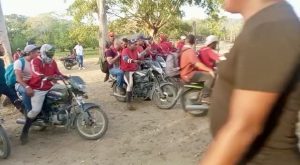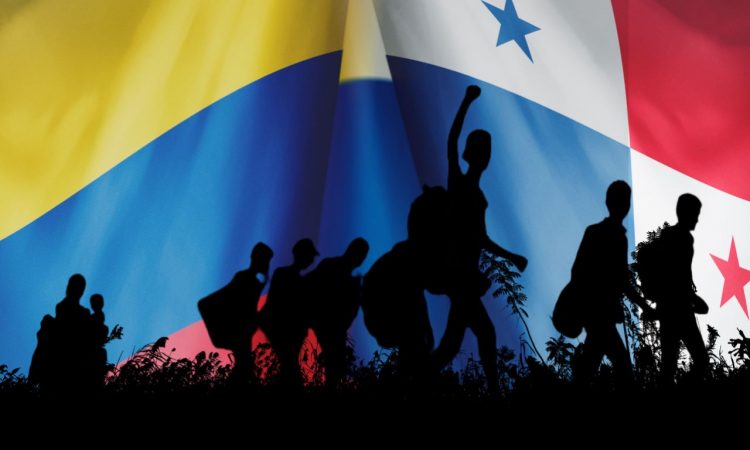Key Findings:
- The Colombia-Panama border, where the Darién jungle is located, is a lawless zone dominated by criminal organizations. As it has become a busy crossing for migrants walking from South to North America, human smugglers have made a business out of guiding them across rushing rivers and steep mountains for around three days.
- Migrants walking over the Darién Gap face the risk of being robbed, kidnapped, raped, and/or scammed. Smugglers offer migrants different routes at lower and higher fees, depending on the risks they imply.
- Migrants mainly use WhatsApp to communicate with others along the way to the United States and keep themselves informed. However, WhatsApp groups are also the main source of misinformation about migration rules and the main platform for smugglers to promote their services to guide migrants across the Darién Gap.
Overview
The Darién Gap is the sole territory where the Pan-American Highway, connecting the Americas from Alaska, United States, to Tierra del Fuego, Argentina, is incomplete. Located on the Panama-Colombia border, Darién is a rainforest made up of swamps, rushing rivers, and steep mountains. Around 13,000 people of different indigenous communities, including the Guna, Emberá, and Wounaan, are settled across the Darién jungle.
Not only nature makes this roadless territory impenetrable; transnational criminal groups do too. The Gulf Clan (Clan del Golfo), the dominant narco-paramilitary group in Colombia, rules the area. Also known as the “green hell,” Darién is one of the busiest crossings for migrant flows traveling from South to North America.
In 2023, the number of illegal migrants walking over the Darién Gap has ballooned. In January–February 2021, Panamanian migration officials identified around 4,000 illegal migrants crossing the Darién Gap. In the same months of 2023, the figure reached 49,291.
Although most illegal migrants crossing the Darién Gap come from South America, Africans and Asians account for 4 and 10 percent of registered migrants in early 2023, respectively. In fact, in the first quarter of 2023, Chinese migrants became the fourth largest group. Only Haitians, Ecuadorians, and Venezuelans have accounted for a larger percentage of migrants walking over this hostile territory.
This investigation seeks to explain how migrants cross the Darién Gap and explain the risks they face on their path to the United States. The Impunity Observer spoke with a human smuggler—or “guide,” as coyotes call themselves—and multiple migrants via social media. Interviewees asked to remain anonymous due to the fears of identification and reprisal.
Reaching the Darién Gap
To learn more about the transportation routes and prices, an Impunity Observer researcher pretended to be a potential migrant aiming to hire a coyote. The smuggler he talked to offered different routes, with different prices and risk-exposure levels.
The most dangerous routes cost the least, currently starting from $320 for one adult. The most expensive ones, which can cost up to $1,200, are the least risky.
Fees for children two to eight years old are between $70 and $150. For children nine to 12 years old, fees vary from $120 to $200. Those older than 12 years old must pay the same fees as adults.
The starting point for most routes is the coastal city of Necoclí, which is an eight-hour bus ride from Medellín—the second most-populated city in Colombia. Other routes begin at Arboletes, the northernmost city in Antioquia, Colombia.
The bus ride from Medellín to Necoclí costs around $20 per person, and buses operate from 5 a.m. to 11:50 p.m. The guides pick up migrants at the bus stop and immediately ask for the fees for crossing the Darién Gap.
Migrants sleep one night in Necoclí and eat a meal—both included in the price. Rested and nourished, migrants and coyotes meet at the Necoclí port the next morning.
In a boat ride of around 90 minutes, guides take migrants from Necoclí to Acandí or Capurganá—the closest Colombian cities to the Panamanian border and the Darién Gap.
Smugglers recommend each migrant travel with: (1) a pair of mountain boots, (2) one lantern, (3) oral serum (to treat dehydration), (4) comfortable clothes for hiking, (5) panela (sugar), (6) water-treatment tablets, and (7) at least one five-liter bottle of water. Each family or group should also carry: (1) one tent, (2) one portable stove, and (3) one first-aid kit.

Multiple Routes for the Crossing
The cheapest routes for crossing the Darién Gap may be the “most challenging journey that anyone can experience in life,” as one migrant said in the WhatsApp group the Impunity Observer got access to.
According to the interviewed guide and migrants, the length of the routes depends on how fast people walk and their stamina. Guides often continue with the group and abandon the slowest people in the jungle.
The following are the routes for crossing the Darién Gap that the guide offered the Impunity Observer researcher:
Acandí Route ($320): It takes around a two-and-a-half-day walk through rushing rivers and steep mountains. When reaching Acandí and before crossing the Darién Gap, migrants eat a light meal. Then the guide provides them with a vehicle—either motorcycles or horses—to reach a camp called Las Tecas, where migrants cross the border. A new guide helps them to cross the border until they reach Tres Bocas, the Darién province in Panama.
Capurganá Route ($320): When reaching Capurganá, the guide offers a meal, and then the group starts hiking. One guide explained that this route is different from the old Capurganá route, where migrants had to walk for five to six days in the jungle. On this route, migrants will have to walk for around two days and a half before leaving the jungle.
Similar to the Acandí route, migrants reach Las Tecas, but they do it by walking. The guide accompanies the migrants until just before reaching Panama, at which point migrants have to follow a path by themselves. The difference between this and the Acandí route is that the migrants follow different guides for each portion of the route.
Carreto Route ($450): The guide describes the Carreto route as “excellent.” According to him, there have been zero cases of rape and robbery on this route, in contrast to the other routes where multiple cases have been reported.
When reaching Carreto, migrants rest and eat to recover energy. Similar to the previous routes, migrants have to walk for around two and a half days before exiting the jungle. However, there are fewer steep mountains and rushing rivers to cross.
Caledonia Route ($1200): Migrants going through this route will “barely have to walk,” asserts the guide. For this route, migrants will have to go to Capurganá, where they will get on a boat to reach Caledonia Bay.
Once in Caledonia Bay, Panama, the guide will provide transportation—a car or a horse—to circumvent the jungle. Migrants have zero interactions with the steep mountains and rushing rivers.
In addition to meals and vehicles, the prices include extortion fees charged by gangs and local communities to pass through their territories. While these groups usually allow migrants to safely pass after payments, others ask for more money or assault migrants.
When leaving the Darién Gap, migrants usually encounter Panamanian Migrant Reception Stations (MRSs). With the support of multinational organizations, such as the United Nations and the International Migration Organization, the Panamanian government has established three MRSs on Darién’s outskirts since 2020.
With personnel made up of Panamanian officials and staff of UN units and migration-focused NGOs, MRSs provide migrants information, medical care, lodging in tents, and food. MRSs have the capacity for hosting 500–700 migrants per week.
Common Dangers
- Extortion and kidnapping
Due to the presence of criminal groups on the Colombia-Panama border, migrants crossing the Darién Gap face dangerous and deadly scenarios.
On the Colombian side, the Gulf Clan dominates the territory, including its human trafficking, according to the Colombian Ideas for Peace Foundation. Due to the cartel’s relative monopoly, violence and murder rates remain low. Still, the Gulf Clan has been accused of perpetrating extortion, kidnapping, and torture across the Darién Gap.
On the Panamanian side, in contrast, anarchy and violence reign. A wide number of gangs ambush migrants along the way to assault and rape them.
- Assaults and rape
Migrants crossing the Darién Gap are usually targets of local robbers, kidnappers, and rapists.
In September 2022, for instance, a robber assaulted a family in Tres Bocas—the Panamanian territory of Darién. During the attack, the robber shot a six-year-old kid in the face, killing him immediately.
A UN report revealed that over 300 women were raped while attempting to cross the jungle in 2021. Moreover, another UN report, released in February 2023, indicated some personnel at MRSs had been asking for sexual favors from migrants in exchange for assistance or money, which migrants need to continue their journey.
- Land mines
On March 22, Colombian officials stated they had found land mines laid along some routes migrants use to cross the Darién Gap. The statement, however, provides no further detail about the explosives. Colombian officials fear there may be more mines near the Acandí trails toward the Darién Gap, which would endanger the lives of thousands of migrants.
La @PGN_COL alerta por el hallazgo de minas antipersonal encontradas en la ruta que utilizan diariamente miles de migrantes que buscan cruzar el Tapón del Darién para llegar a Panamá, por lo que pide articulación de las autoridades. #EsNoticia https://t.co/w0RSo0pGUm pic.twitter.com/tKI6eNKGQE
— Procuraduría General de la Nación (@PGN_COL) March 22, 2023
- Scams
Since it is an illegal operation, migrants face the risk of getting ripped off by guides, who abandon them in the middle of the jungle before reaching Panama. Although there are no reliable numbers regarding cases of migrants being scammed, such stories are commonplace in local and regional media.
Social Media: A Tool for Migrants, Smugglers
Social media, in particular WhatsApp and TikTok, are the common information channels for migrants. These platforms are also tools for coyotes, who grab the attention of migrants and advertise the benefits of choosing their services.
People interested in migrating to the United States through the Darién Gap were frequently joining the group the Impunity Observer accessed. Some of the members are already in the United States, and others are crossing borders in Central America. This group has more than 830 members from Brazil, Chile, Colombia, Ecuador, Peru, and Venezuela.
In the WhatsApp group, migrants share information about their own journeys, providing information to those who are still considering traveling. In addition, the guide keeps in touch with the migrants who will cross the border in the upcoming days. Migrants often ask if anyone is migrating from their own location, so they can do the trip together.
However, this group and others like it can be dangerous. Few people know each other, so they do not know who they are really talking to. Aware of this situation, one migrant claimed: “Please stop sharing your personal information because it can lead to your exact position.” Some people share misinformation about migration rules of other borders such as the US-Mexico border.
With over 7,200 followers on TikTok, the guide the Impunity Observer talked to offers his services through this platform. In his videos, which get 50,000–330,000 views each, he shows positive feedback messages from previous clients that have used his transportation services. He also shares cheerful messages and captions such as “people are happy” or “these are true warriors.”
The guide uses TikTok and WhatsApp to persuade migrants to choose his services. In the WhatsApp group the guide manages, he encourages migrants to visit his TikTok account, where they will see the experiences of his past groups. Similarly, he encourages people who visit his TikTok to enter the WhatsApp group.
The Trajectory
While there is scant reliable data regarding the Darién Gap, what is available points to a rise in people making the crossing. Ironically, a deadly cartel—the Gulf Clan—appears to be one source of stability, at least on the Colombian side, since it has no clear competitor to fight.
The lawless region is fertile ground for all manner of criminals and conmen. Social media appears to have both helped and hurt potential migrants: providing them with more information but also connecting them with bad actors and encouraging the trip.
Many residents of Third World countries such as Venezuela and Haiti see no future in their home areas. So long as there is vastly greater economic opportunity in the United States, their desperation will continue to drive them to escape and take grave risks. In other words, the problems there are also problems for the United States and all those countries in between. The migration is a symptom of failed states, and technology is opening our eyes to its prevalence.
 Join us in our mission to foster positive relations between the United States and Latin America through independent journalism.
Join us in our mission to foster positive relations between the United States and Latin America through independent journalism.
As we improve our quality and deepen our coverage, we wish to make the Impunity Observer financially sustainable and reader-oriented. In return, we ask that you show your support in the form of subscriptions.
Non-subscribers can read up to six articles per month. Subscribe here.



